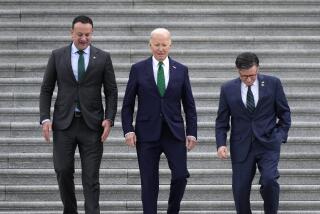National Campaign Fund Faces a Big Shortfall : Elections: Only 19.8% of taxpayers checked the ‘yes’ box on tax form in 1989 to set aside $1 to pay for presidential vote. FEC sees $100-million shortage.
- Share via
WASHINGTON — Only about one in five American taxpayers agrees to set aside a dollar on his or her income tax form to fund the presidential election campaigns, which will result by 1996 in a shortfall of more than $100 million in the public campaign fund, Federal Election Commission officials warned Friday.
A huge deficit in the election fund is “virtually assured” by 1996, FEC Chairwoman Joan Aikens said, unless more taxpayers check the “yes” box on their tax forms or Congress revises the funding law.
Ironically, interviews with taxpayers found that many are disturbed that public officials are unduly influenced by private contributions from special interests. At the same time, they are so angry at politicians and upset by what they see as “wasteful spending by government” that they refuse to approve a $1 contribution for the public election fund.
Checking the “yes” box on the tax form actually costs the taxpayer nothing.
As income tax forms are being sent out to 110 million households, the FEC said Friday it is beginning a round of public service spots on TV and radio to encourage taxpayers to make “an informed choice” about whether to contribute to the election fund.
The public campaign fund, which began with the 1976 election, gives matching contributions to presidential candidates in the primary elections and provides the major source of funding for the two candidates in the general election. This year, the Republican and Democratic candidates will receive $55 million to run their fall campaigns.
The fund is intended to reduce the candidate’s dependence on private contributions and to put the competitors on a more equal footing.
“This is the one time you can exercise some control over how your tax dollars are spent,” Aikens said.
If so, most taxpayers are saying they do not want their tax money spent on political campaigns.
In the late 1970s, more than one-fourth of taxpayers checked the “yes” box to contribute to the campaign. In 1980, the percentage hit a high of 28.7%. Since then, it has dropped steadily, reaching a low of 19.8% in 1989, the most recent year for which figures are available.
Because of declining contributions and the impact of inflation, the FEC had expected to run short of money this spring. But because the presidential campaign started late and fewer than expected candidates entered the field, the FEC says it expects to fund all its obligations during 1992.
The 1991 contributions from taxpayers yielded $32.2 million for the election fund, the lowest total since 1976.
This year, the FEC says it will distribute $110 million for the fall campaigns, including $42 million for the primary campaigns and $22 million for the nominating campaigns.
Though the percentage of taxpayers contributing $1 has slowly declined, Aikens said the election fund has been hurt even more by inflation. In 1974, Congress said the spending limits for general election candidates should rise with the cost of living. While the limit for the general election campaign began at $20 million per candidate, it has risen since then by 280% to this year’s $55 million total, she said.
To head off a “serious shortfall” in the next election cycle, the FEC urged Congress either to raise the amount on the taxpayer contributions or to replenish the election with regular appropriations.
More to Read
Get the L.A. Times Politics newsletter
Deeply reported insights into legislation, politics and policy from Sacramento, Washington and beyond. In your inbox twice per week.
You may occasionally receive promotional content from the Los Angeles Times.











